Security Models#
The essence of information security is to protect information. It is just that simple. Do not make it more complicated.
Complexity for cyber security and privacy arise when information needs to be shared or must be made accessible.
Proven security architecture and models help when creating a solution for your use case.
Tip
Reuse Security Models Save time and money: Reuse existing open security models!
Adjusting existing models for your problem situation saves time and improves the quality for your solution!
A good visualisation of a security model is easy to use for communication. So instead of explaining what the essence of information security is: Use a model to facilitate crucial conversations.
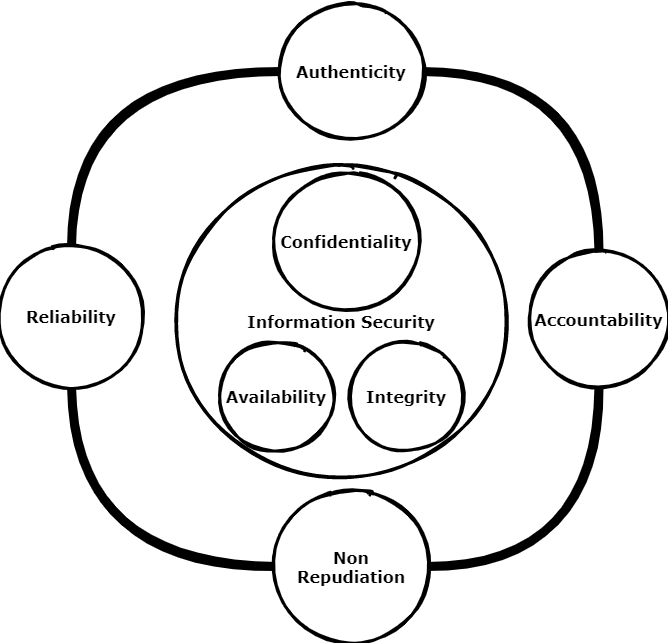
The essence of information security is to protect information. It is just that simple. So whenever possible do not make it more complicated than needed. Complexity for cyber security and privacy arise when information needs to be shared or must be made accessible by some digital device. The world where information was only available in physical archives are long gone. The focus from physical information security is shifted to cyber information security. But be aware: Crucial principles of centuries of physical information protection are still valuable today. Especially principles related to the intangible soft issues when information is shared. Ever wondered how some organizations managed to keep their valuable information secret for many decades?
Information protection is needed against:
unauthorised access
use
disclosure
modification or
destruction. That means several security measures are needed to protect information from unauthorised viewers.
Measures can be implemented by procedural, physical or with complex IT tools. But before classifying and creating or finding good measures it is essential that the problem field is made clear.
Creating effective solutions for information security problems can be done by creating a model of the problem situation. Within a model all elements that relate with the problem situation are brought together to study effective solutions. Without going into detail on system science or problem solving theory: in general systems consist of subsystems, objects, functions or processes, and activities or tasks.
The key in creating a good model to solve a specific information security problem is to model the problem, not the complete system with all elements. This because modelling the world completely is ineffective, time consuming and it does not give a direct answer to solve a problem situation. It is far better to start with a small model of a problem and create extensions on this model if needed.
The field of modelling problem situations to solve information security problems is not new. Many models in literature exist. Reusing a good model can save you time and safeguards you from making mistakes. A prerequisite is that you start with a good model that can be trusted and is intensively reviewed by large numbers of subject matter experts.
There are many good security models that can assist in creating a solution architecture to solve a specific security problem for an organization. Mind that a model can be expressed in many different forms. E.g.:
One or more images;
Text;
Software model
Within the field of modelling a distinction can be made between ‘hard’ and ‘soft’ models. Hard models are often mathematical (risk) models whereas soft models are more quality based models. Since using hard models often gives a false sense of reliability and requires full insight of all assumptions made it is more productive to reuse soft security and privacy models. When creating solution architecture, you need:
A threat model (what are the threats your solution gives protection against)
Insight in commonly used attack vectors. This means you need to have some view on the attack vectors used in the use case?
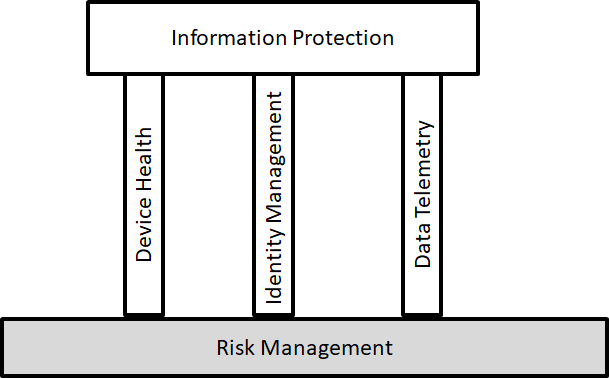
Creating a good security or privacy design or architecture means you never ever start with selecting tools for solving your problem! Selecting tools should be the last phase of your security or privacy design phase. You select tools when it is clear how that the tool supports you in solving your security or privacy problem. Tools alone are never enough to solve security or privacy problems. You need to fit in tools within your security and privacy processes. Several problems exist and arise with many IT security tools that hit you when you start too soon with a focus on solutions instead of a thorough problem diagnosis and solution design. Wrongly selected security and privacy tools give the following issues:
High costs;
Complex challenges to implement and manage;
Daily administration of a chosen tool set requires significant IT effort while it remains unclear if the tools are effective in reducing security risk;
Overlap in functionality of security application landscape. More is not always better. To be able to justify the application of security tools for your problem a context specific security architecture should give input to the following questions:
What is protected with what?
What are the main threats we need protection against?
What is not protected by information security policies or tools?
What is in scope or out of scope for your security architecture? E.g. business continuity management, safety management, financial risk management, daily IT operations, physical (building) security etc. In the end everything has a relation with information security, but you cannot cover all business aspects using an information security architecture document. The key is to focus and keep the scope clear or else the complexity becomes overwhelming.
What architecture or design decisions have been made and must be validated explicitly?
What is the model of your protection? It is far more easy to evaluate and improve a model, than adding new or improved security products continuously. Make sure that within operational security management processes learning and improving are key periodic targets.
Does the security model cover all crucial security and privacy principles and requirements?
Are the residual risks when this solution acceptable for the key stakeholders?
IT security in general is seen as a complex problem field, due to the many technical and nontechnical aspects involved. Since 100% information security is impossible, being able to qualify risks is crucial in getting an accepted level of security protection. Good modelling helps you to qualify security and privacy risks.
In general, it is far more easy to reuse proven concepts and models when creating your own security model. This way you build on the work of others and using a good model reference reduces the risk of making crucial mistakes.
ATT&CK#
ATT&CK stands for Adversarial Tactics, Techniques, and Common Knowledge. MITRE started this project in 2013.
ATT&CK is largely a knowledge base of adversarial techniques — a breakdown and classification of offensively oriented actions that can be used against particular platforms, such as Windows. Unlike prior work in this area, the focus isn’t on the tools and malware that adversaries use but on how they interact with systems during an operation.
The relationship between tactics and techniques can be visualised in the ATT&CK Matrix.
The ATT&CK Matrix is probably the most widely recognizable aspect of ATT&CK because it’s commonly used to show things like defensive coverage of an environment, detection capabilities in security products, and results of an incident or red team engagement.
The complete Matrix and all guides and information can be found at: https://attack.mitre.org/
Industrial Internet Reference Architecture#
The IIRA is a standards-based reference architecture. It is a good reference to use when working in a IoT or industrial context. It is aimed at system architects to make their own design faster and better by using a common framework and concepts.
Check: https://www.iiconsortium.org/IIRA.htm
Or see the PDF-book at: https://www.iiconsortium.org/pdf/IIRA-v1.9.pdf
note:IIRA is NOT open access
Jericho Security Model#
The Jericho™ Security architecture model is built upon principles. The advantages of using the Jericho model for security are:
A security architecture model built upon the Jericho conceptual model is built around maintaining flexibility and protects the most important security objects for the stakeholders.
Integration: Easier to build secure processes with other companies and trusted partners.
Simplifies use of public networks and cloud solutions
Aimed for use of open principles and open solution building blocks.
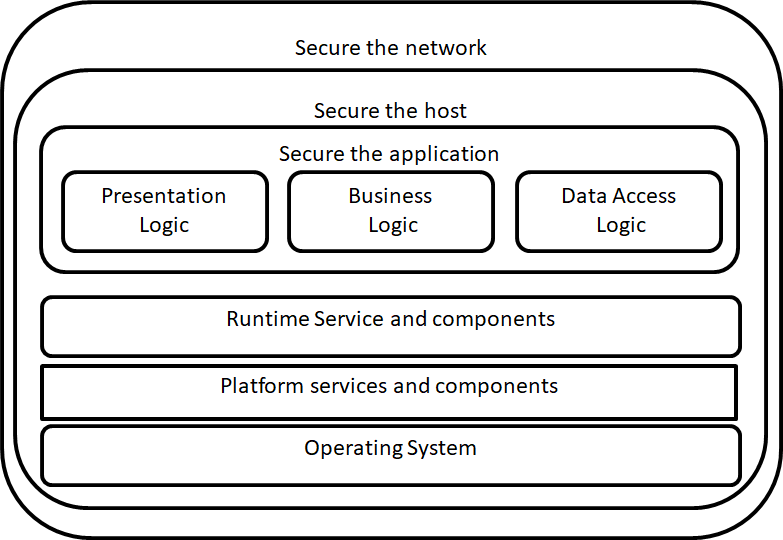
Unfortunately the Jericho framework is not a real open security framework. It is copyrighted by the open group (see references chapter for more information on this model). There are trademarks involved and all publications are copyrighted. However due to the work of many we can make use of the developed knowledge within the Jericho working group. The Jericho Forum®, a forum of The Open Group, was formed in January 2004 and is no longer active. However, the approach of this forum towards security is still alive.
NIST:Cloud Computing Security model#
Sooner or later you create a solution or privacy architecture where cloud hosting plays a significant part. The NIST cloud computing security reference model is a very good model to use as reference.
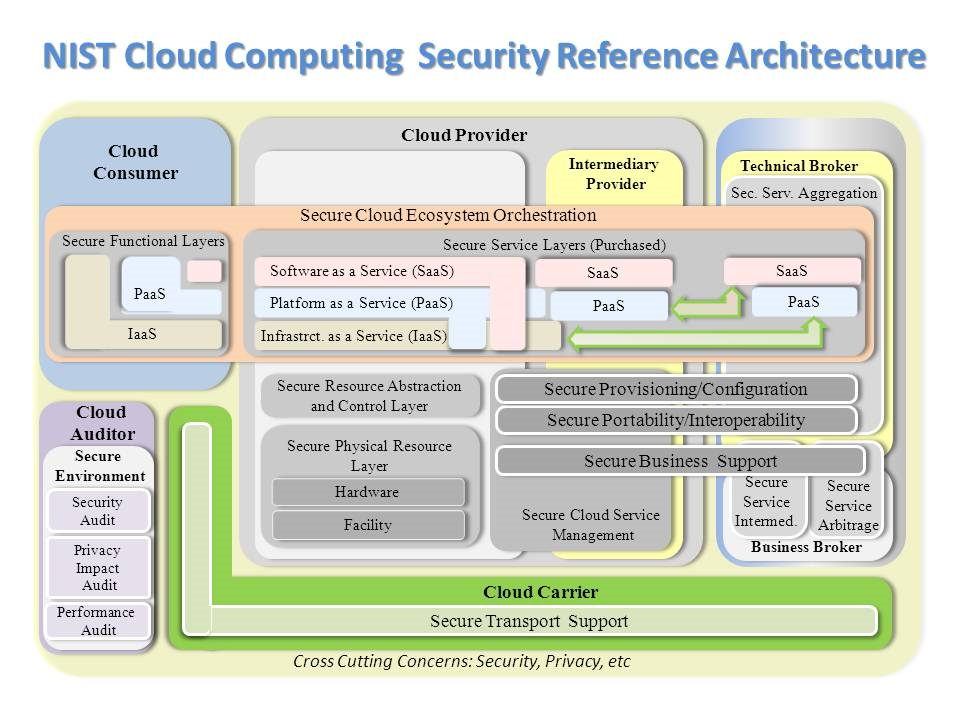
Open Security Architecture Landscape(OSA)#
Thanks to the Open Security Architecture (OSA) group there is a real open security landscape: https://www.opensecurityarchitecture.org/.
All OSA material is CC by sa licensed, which means you can freely use and improve it.
Below is the OSA Security architecture landscape:
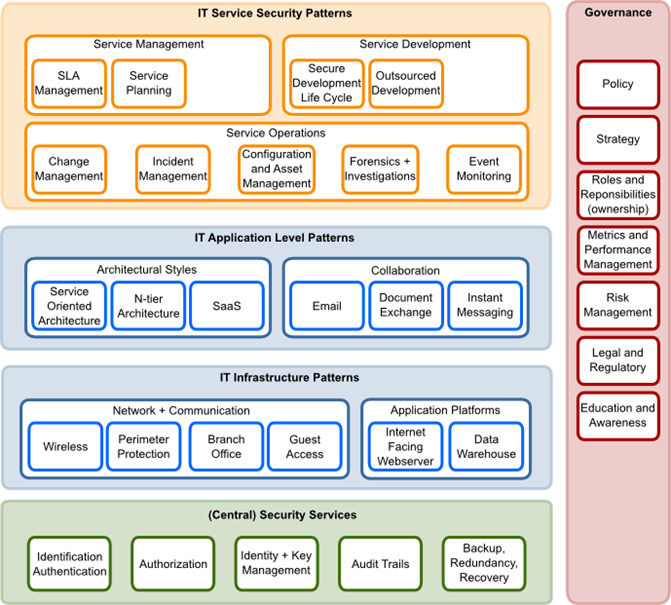
Link to OSA: https://www.opensecurityarchitecture.org
The OSA Security architecture is based on patterns. Which mean for every pattern defined the aim of the community was/is to develop a standardised solution description. Unfortunate the OSA community is not very active anymore, so all IT security patterns around cloud are not yet incorporated.
For a number of reasons we have chosen not to use patterns in this security and privacy reference architecture. However in some cases using patterns can give an advantage. (See the Introduction, section ‘What about security patterns?’ for more information).
OpenTitan Security Model#
OpenTitan is an open source project for building a transparent, high-quality reference design and integration guidelines for silicon root of trust (RoT) chips.
OpenTitan will make the silicon RoT design and implementation more transparent, trustworthy, and secure for enterprises, platform providers, and chip manufacturers. OpenTitan is administered by lowRISC CIC as a collaborative project to produce high quality, open IP for instantiation as a full-featured product.
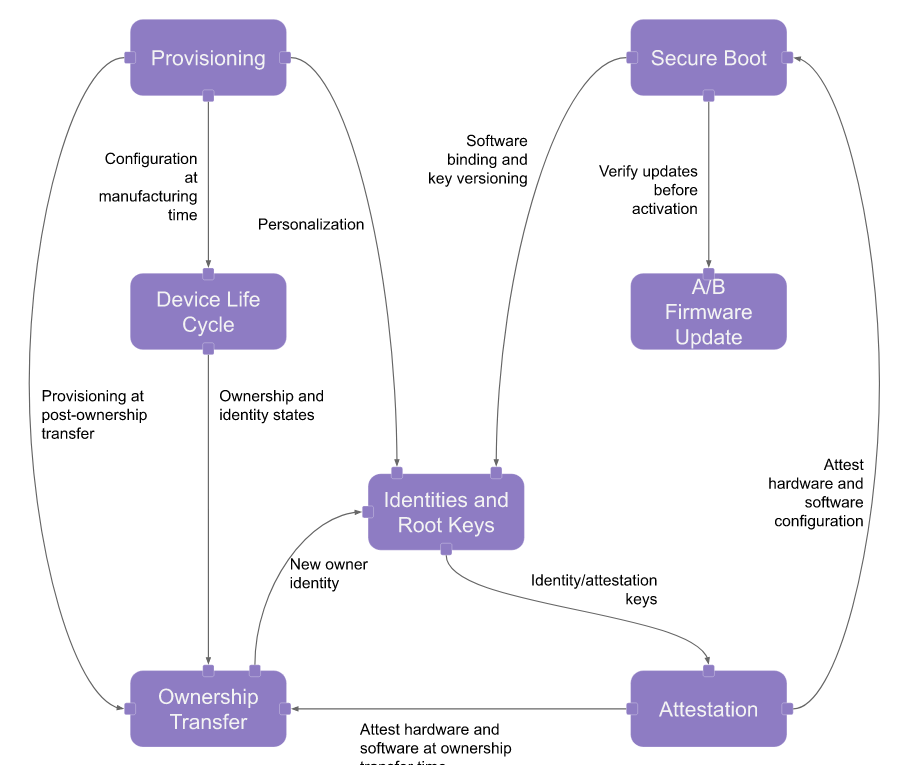
(Image source - license: Apache License, Version 2.0)
Link for info on Open Titan project: https://opentitan.org/ or see the docs at https://docs.opentitan.org/)https://docs.opentitan.org/https://docs.opentitan.org/)
System Transparency architecture#
System Transparency is a security architecture for bare-metal servers. System Transparency protects and makes your boot chain auditable. It uses LinuxBoot, TPM, and Intel TXT. It is reproducible, with plans to incorporate Binary Transparency. Correctly integrated it can make a system transparent to you and even your end users. This architecture is not only a concept, but has code to create an environment for System Transparency.
Software Assurance Maturity Model (SAMM)#
The Software Assurance Maturity Model (SAMM) is an open framework to help organizations formulate and implement a strategy for software security that is tailored to the specific risks facing the organization. SAMM is useful resource if you are working on a process architecture that is needed to control all kind of aspects of software security. Our advice is to take the processes as defined in SAMM as point of departure within your security process design documentation. Formulating processes yourself in not productive, so use this valuable source of information instead of reinventing the wheel.
January 2020 version2 of the SAMM model is released. This to incorporate devops security practices and overcome limitation of the earlier version.
To get the baseline situation of your security process architecture fast in scope, you can use a SAMM self-assessment test (see APPENDIX). Using a self-assessment test you can get a very quick overview on the status of the IT security processes within your organization. SAMM is an OWASP project.
SAMM aids in:
Evaluating an organization’s existing software security practices
Building a balanced software security assurance program in well-defined iterations
Demonstrating concrete improvements to a security assurance program
Defining and measuring security-related activities throughout an organization
As an open project, SAMM content shall always remain vendor-neutral and freely available for all to use.
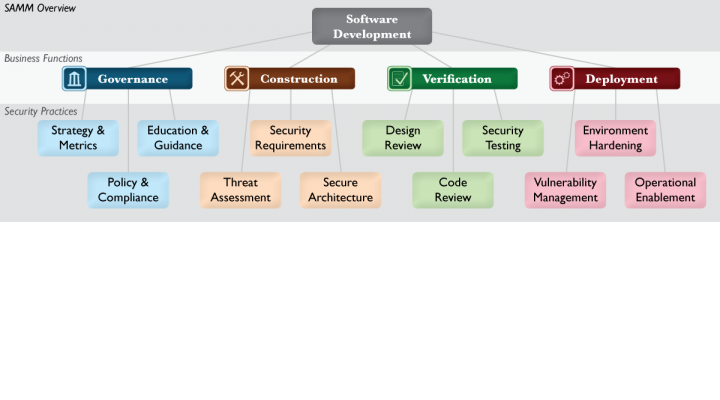
Source: OWASP
Reuse of the SAMM process and usage should be encouraged. This OWASP project is like all OWASP projects a real open project. All content is available under a Creative Commons License (by-sa). If you want to improve this SAMM framework, OWASP is a real open foundation where everyone can participate without borders. Also all communication and collaboration is truly open.
The SAMM model was first aimed at evaluating the status of software security within an organization. However due to the use in practice the framework can also be used to improve many other aspects surrounding security and privacy.
More info on this SAMM model: https://owaspsamm.org/model/
SDLC Model#
The view below (source OWASP) is a model of how security fits into the SDLC (Software Development and Lifecycle) process. Within almost every solution architecture you should take the SDLC into account to position where your solution fits and how maintenance is positioned within the SDLC phases.
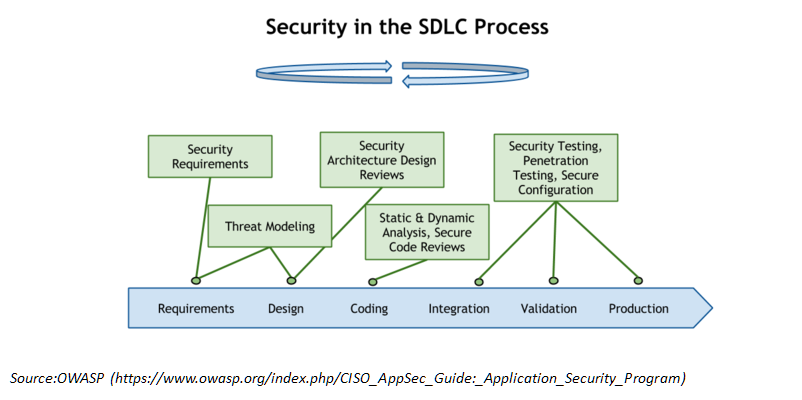
Security and privacy should be embedded in the SDLC process. Always. The OWASP conceptual model of the (simplified) SDLC chain shows on high level where security activities hit the SDLC process.
Robot Hacking#
Robots are more and more used on various places. E.g. robots are used in homes, in assembly lines in industry and are deployed in medical facilities. But robot security is still underestimated.
The Robot Security Framework (RSF)is a standardised methodology to perform security assessments in robotics. The model is GPLv3 licensed and can be found here: aliasrobotics/RSF
Zero Trust model#
A typical enterprise’s infrastructure is increasingly complex. A Zero Trust architecture model is seen as a good solution for protection.
ZT (Zero Trust) is not a single architecture but a set of guiding principles for workflow, system design and operations that can be used to improve the security.
The Zero Trust model eliminates trust in any one element, node, or service by assuming that a breach is inevitable or has already occurred. The data-centric security model constantly limits access while also looking for anomalous or malicious activity.
Adopting the Zero Trust mindset and leveraging Zero Trust principles will enable systems administrators to control how users, processes, and devices engage with data. These principles can prevent the abuse of compromised user credentials, remote exploitation, or insider threats, and even mitigate effects of supply chain malicious activity.
NIST Document : Zero Trust Architecture
Microsoft Zero Trust Maturity Model: document
